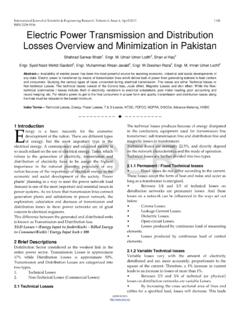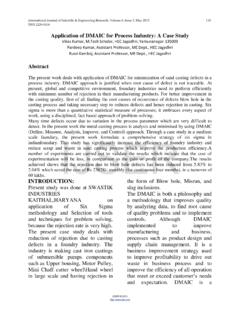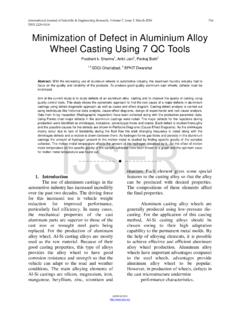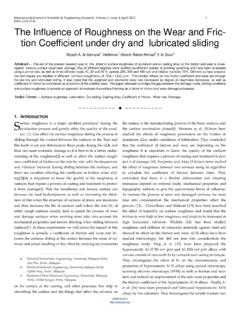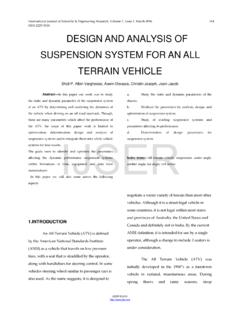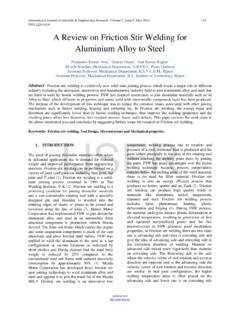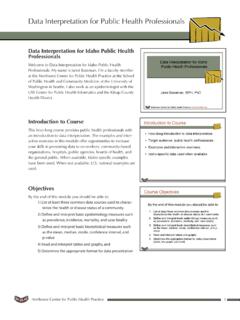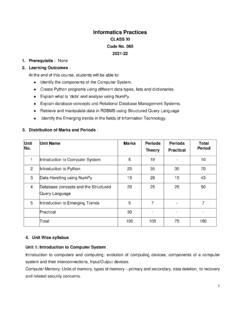Transcription of The Implementation of Electronic Health Record Systems ...
1 International Journal of Scientific & Engineering Research, Volume 5, Issue 3, March-2014 322 ISSN 2229-5518 IJSER 2014 The Implementation of Electronic Health Record Systems : The factors influencing the successful Implementation of Electronic Health Record Systems . Mayowa Olayemi Akomolafe Abstract The Electronic Health Record is a very important technology to improve the Health care delivery, but the Implementation has been challenging. However despite of all the benefits, physicians are not showing interest in adopting the technology and to compete well in today s market all Health institutions must explore the opportunities of the new technology. The aim of this paper is to critically analyze the factors which influence the successful Implementation of the EHR achieve the successful Implementation of EHR there is need for involvement and participation of all the relevant stakeholder groups in the Health sector.
2 Involvement and the dedicated attitude of users is very important to achieve Implementation success. A good leadership skill and change management strategy is also very important to manage people. The end users should be communicated too as early as possible to involve them in Implementation . Assessing the workflow and ensuring a continuous workflow in the organization is very important. Interoperability is one of the major barriers that must be addressed in implementing an EHR. Staff training on their new job role will facilitate Implementation and improve work efficiency and this will help to minimize time spent. Finally, evaluating the organizational needs is also very important in Implementation . Index Terms Ambulatory care, adoption, interoperability , patient s referral , system monitoring , workflow, workers resistance.
3 1. INTRODUCTION he Implementation of Electronic Medical Record is very important to improve Health care delivery and increases patients safety (Hillestad ,2005). It is also important to meet the challenges of documenting, communicating and evaluating effectively in the Health system, therefore information and communication system should be implemented (Blobel, 2004). The Institute of Medicine said Electronic Health Records (EHRs) must be implemented widely to achieve a better Health delivery service and to provide a better safety for patients (Institute of Medicine, 2001; Institute of Medicine, 2006 and Bates et al, 2003) and the adoption of EHRs will improve ambulatory care in term of cost (Hillestad ,2005 and Miller et al, 2005).
4 Adopting the EHR will aid advanced examination potential and provide better assessment and improved quality care (Jensen et al, 2009). Also the National Alliance for Primary Care informatics said by the time Electronic Health Record is widely adopted, it will provide better Health care safety and will aid research (Bates et al, 2003). However despite of all the benefits, physicians are not showing interest in adopting the technology (Massaro, 1993 and Loomis et al, 2002) and to compete well in today s T IJSERI nternational Journal of Scientific & Engineering Research, Volume 5, Issue 3, March-2014 323 ISSN 2229-5518 IJSER 2014 market all organizations must explore the opportunities of new technologies (Lauer et al, 2000).
5 Any Information and Communication Technology ICT used in the Health care system is assumed to be contributing to the increase in quality of Health care, therefore the Implementation should be subject to incessant quality improvement (Talmon, 2006). The potentials of Health Information Technology has been said to be numerous in Health delivery and in improving Health care (Blumenthal and Glaser, 2007). Surprisingly, MGH Institute for Health Policy (2006), said the adoption of EHR is going at a very slow rate less than what was expected (Cited by Houser and Johnson). Therefore, to explore these opportunities, there are challenges to be faced in implementing and utilizing the technology (Lauer et al, 2000).
6 Although these benefits are great but they have not superseded the barriers (Giannini and Johnson, 2008). Although, the major challenges affecting Implementation are human factor, organizational and leadership problems (Wyatt, 1995; Dick et al, 1997 and Lorenzi and Riley, 2000). Also a large sum of money will be required to implement an Electronic Health Record (Schmitt and Wofford & Kuperman and Gibson , 2003) which also requires good managerial skill for the Implementation to be successful and to ensure its efficient use by Health professionals (Poissant, 2005). 2. STAKEHOLDERS Terry et al (2008) said for the successful Implementation of EHR there is need for involvement and commitment of all the relevant stakeholder groups in Health .
7 According to Van DerMeijden et al (2003), he said a system has failed if it is completely rejected by the users, although the success of a system cannot actually be defined. He said success can be determined by evaluating the settings where it will be used, the purpose of the system and the stakeholders involved in the use. Lorenzi et al (1995) said the technically best system may be woefully inadequate if its Implementation is resisted by people who have low psychological ownership in that system. On the other hand people with high ownership can make a technically mediocre system function fairly well A reasonable approach to designing a new system is to involve the end users of the system (Robey, 1979) because to achieve success in Implementation , human being consideration is very important (Ang et al, 1995; Johnson and Davis, 2004; Fenton et al, 2006 and Adler, 2007).
8 Involvement and dedicated attitudes of stakeholders in the Health sector are very important in the Implementation of Electronic Health Record (Mount et al, 2000). Singleton et al (2007) in his work listed the five stakeholders to be involved in the Implementation of EHR as patients, the general public, all professional involved, managers or administrators and the application vendors. An important success factor is involving people and patients connected to the practice as part of the Implementation team and this will ensure that their information needs are taking into consideration (Mount et al, 2000). EHR must be accepted among doctors, nurses and other Health professionals for it to be successfully implemented (Mohd and Mohamad, 2005).
9 Houser and Johnson (2008) said ignorance about EHR and non-c ooperation of clinical staff have contributed to the Implementation failure of EHR. Moreover, Implementation is said to be a failure if employees do not show care about it or they fail to use it to full capacity in other to achieve its full potential (Klein and Sorra, 1996), attitudes of users about the system determines their use (Robey, 1979) and for a technology to be fully accepted it depends on the adjustment of the users to the new environment (Doebbeling et al, 2006). The managers attitudes and the users view about a technology affect their readiness to use it and it will affect the Implementation (Leonard-Bartonan and Deschamps, 1988 cited by Edmondson et al, 2001) because successful Implementation entails the frequent use of the technology on a daily basis in the establishment (Szulanski, 2000 cited by Edmondson et al, 2001).
10 Therefore, it is very IJSERI nternational Journal of Scientific & Engineering Research, Volume 5, Issue 3, March-2014 324 ISSN 2229-5518 IJSER 2014 important to involve staff early enough so as to commit them into the Implementation process (Lorenzi et, al, 2009). It is also important to invite the vendor into the Implementation plan (Swanson et al., 1997), for him to understand the existing workflow and organizational needs before Implementation (Chin and Krall, 1997; Keshavjee et al, 2006). As a start vendors should be required to build data model using the standard clinical data format (Bates, 2005). However, the technology to be adopted should be simple to install and managed locally and easily adapted to suit the purpose of other Health Institutions (Lorenzi et al, 2009).
